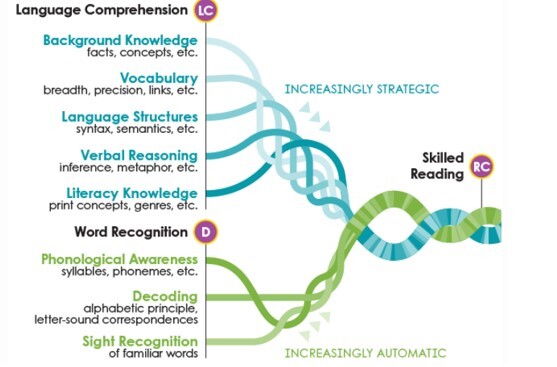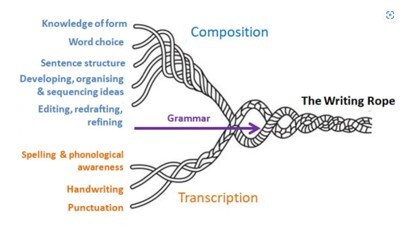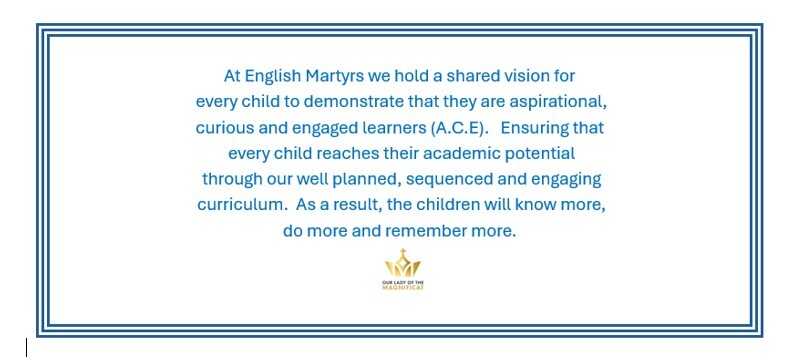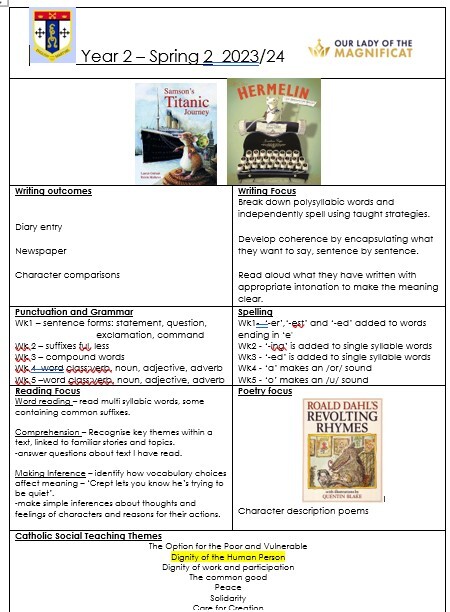- Home
- Curriculum
- Subject Information
- English  ...
English
Reading
What does this look like in Reading?
At English Martyrs we deliver a high-quality aspirational English reading curriculum which develops and fosters a whole school love of reading. We aim for our children to be aspirational, engaged and curious readers. Through reading lessons, we make links between our chosen core texts and our Catholic Social Teaching themes and Fundamental British values. We read a variety of texts with links to our topics and our wider curriculum subjects.
Curriculum Intent:
Children in EYFS, 1 and 2 are taught reading through the Little Wandle Phonics and reading fluency programme. In EYFS this happens daily. In years 1 and 2 this happens at least three times a week. It focuses on decoding, prosody and comprehension.
In KS2, reading is taught through discreet reading sessions planned by class teachers to meet the Primary National Curriculum reading scheme of work objectives and skills for their Key Stage.
Reading for Pleasure is timetabled across all year groups. Reading is modelled by staff when reading aloud, including discussion of inference and the comprehension process. Reading for Pleasure texts are chosen from recommended year group reading lists.
Our Reading curriculum is inclusive, we deliver a talk rich, targeted curriculum to all of our pupils irrespective of specific learning needs or disabilities. We adapt teaching and learning where necessary to ensure all children can access the reading curriculum through scaffolded activities, in class support, flexible environments and a variety of learning activities.
Curriculum Implementation:
Each lesson focusses on a manageable step of new learning based on the National Curriculum Reading Scheme of work.
What a typical lesson looks like:
Flashback: an opportunity for pupils to retrieve and build upon previously acquired skills, through a ‘Last Lesson, Last Unit, Last Year, Challenge’ approach.
Teach it: Introduction to new learning with live modelling and explicit addressing of potential misconceptions.
Practise it: Children are given the opportunity to practise and use new skills. Learning can be independent and collaborative, all pupils participate through active learning strategies.
Prove it: Using Scarborough’s reading rope model, children apply new knowledge and reading skills: Phonological awareness, decoding (alphabetic principle and letter-sound correspondences), sight recognition, background knowledge, vocabulary, language structures, verbal reasoning and literacy knowledge.

Assessment:
All year groups complete PIRA reading assessments 3x a year (Year 2 and 6 SATs papers). Teachers complete PIRA QLA documents to identify gaps and areas of need for individual pupils as well as the class cohort. Teachers use QLA data to inform future planning and teaching. Continued monitoring and assessment through questioning and observing in each lesson also informs planning.
Curriculum Impact:
At English Martyrs we believe that reading is the key to unlocking all curriculum areas of learning. We focus our time, resources and dedication into reading sessions across the school to ensure that all children are making good progress in their reading and become independent, lifelong readers. We feel passionate about our pupils developing a love of reading and so we ensure that they are exposed to and immersed in a variety of text types, genres and authors inside and outside of their classroom.
Monitoring, Evaluation and Review
Teaching and learning of reading is captured through: Lesson drop ins, questioning, pupil voice, book looks, planning monitoring, NC objectives coverage monitoring, data drops (termly) and pupil progress follow up, internal and MAC moderation, Little Wandle assessment, Year 2 and Year 6 SATs results, Year 1 Phonics screening scores, PIRA Assessments 3xYear (Reception 2xYear).
Writing
What does this look like in writing?
At English Martyrs, we deliver a high-quality aspirational English writing curriculum which develops and fosters a whole school love of writing. We make links between our chosen core texts and our Catholic Social Teaching themes and Fundamental British values. We write with links to our texts and our foundation subjects.
In whole class sessions, we use a range of talk rich activities to ensure all children are actively learning and engaged English lessons. We are dedicated in ensuring that all our children become aspirational, engaged and curious writers.
National Curriculum objectives are tracked by teachers through their planning to ensure coverage of all skills and knowledge in all areas of the writing scheme of work; spelling, handwriting, writing composition, vocabulary, grammar and punctuation. Planning is scaffolded and adapted to meet the writing needs of all learner groups.
Curriculum Intent:
At English Martyrs, writing is planned and taught using focus CLPE core texts. These texts are chosen by teachers with consideration of their class cohort needs. Sequential and coherent planning immerses children within a writing style that they can independently produce at the end of the lesson sequence. The children are taken on a journey to become immersed in the writing style.
Through CLPE activities and Talk For Learning strategies, we create a talk rich environment to develop pupils vocabulary and language knowledge and skills for independent writing. We have a poetry focus every term to build and develop pupils range of word and language patterns for independent writing.
Using Letterjoin programme, we plan sequential and coherent handwriting lessons to ensure children develop a legible and fluent cursive script.
We follow the Spelling shed scheme of work to plan sequential and coherent spelling lessons to ensure children become more accurate spellers.
Curriculum Implementation:
Teachers plan a half termly overview of their teaching and learning of writing, this has focused writing outcomes as well as plotted weekly GPS objectives.
With a writing outcome focus, each lesson focusses on a manageable step of new learning based on the National Curriculum Writing Scheme of work.
What a typical lesson looks like:
Flashback: an opportunity for pupils to retrieve and build upon previously acquired skills and knowledge, through a ‘Last Lesson, Last Unit, Last Year, Challenge’ approach.
Teach it: Introduction to new learning with live modelling and explicit addressing of potential misconceptions.
Practise it: Children are given the opportunity to practise and use new transcription and composition writing skills. Learning can be independent and collaborative, all pupils participate through active learning strategies.
Prove it: Children apply new knowledge and writing skills: spelling, handwriting, writing composition, vocabulary, grammar and punctuation. These skills are developed and practised in a focused writing style eg. informal letter, persuasive argument.
Dig deeper: To ensure all children are appropriately challenged, the primary national curriculum writing scheme of work is used to plan activities to enable all children to extend their learning forward, broaden their knowledge and make progress at their level.
Assessment
Assessment happens in every lesson using live marking. Children are given learning next steps to develop and move their learning forward.
Writing is assessed formally by the class teacher termly. Teachers use Bromcom to record their assessment of writing and follow this up with pupil progress meetings.
Curriculum Impact:
At English martyrs we believe that all skills on the writing rope are important. We deliver opportunities for all skills to be learnt and developed and we give children time to practise and build on their own writing. It is important to us that our learners are exposed to a variety of learning resources and writing style examples across all areas of the curriculum.

Monitoring, Evaluation and Review:
Teaching and learning of writing is captured through: Lesson drop ins, pupil voice, book looks, planning monitoring, NC objectives coverage monitoring, data drops (termly) and pupil progress follow up, internal and MAC moderation and staff coaching opportunities.
Sample of a English Unit Front cover
Reading - key Documents
Whole School - Reading Progression - Updated May 2025
Little Wandle - Letters and Sounds Progression DocumentLittle Wandle - Letters and Sounds Progression Document
Little Wandle - Phase 2 Pronunciation (Autumn 1)
Little Wandle - Phase 3 Pronunciation (Autumn 2)Little Wandle - Phase 4 Pronunctiation (Spring 1)

